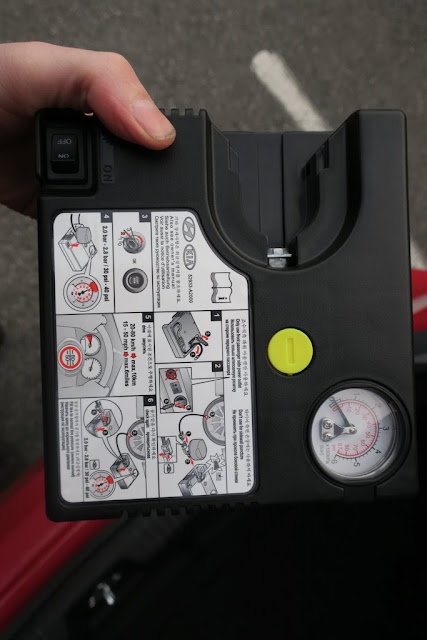I like to poke around rental cars to see how the engine and drive train are laided out and the philosophy and features that are included.
This weeks trip gave me the opportunity to play with a 2015 Hyundai Accent. Aside from the nifty fuel economy button (who wouldn't just leave that on in an econobox?) the other thing that struck me right away was the spare tire. I expect most cars to come with a donut spare, and the real question is if there is enough space for a full size spare down the road.
Well, lets take a look.
Surprise! There is no spare! Instead we have what looks to be extra storage, an electric tire pump, and a can of fix-a-flat.
Actually, this is more of a can of sealant. It's designed to connect to the pump, not the tire.
The can is very heavy and the metal feels thick, likely intended to last a long time in the trunk before use.
Back side of the pump. All the hoses and cables are neatly contained.
Front side of the pump. The can slides in from the right.
I had heard that these were becoming common but this is the first time I have seen one in the wild.
At various times I have chucked the spare tires from our cars into the basement or barn and gone with a can of fix-a-flat. The idea is that a small amount of fuel economy can be gained by reducing the inertia that must be overcome to accelerate. If a tire is blown, I can either use
the fixaflat, or get The Girly or cab to return me to the barn where I
gather my tools and get things rolling again.
However, for trips of distance beyond a normal commute beg for the peace of mind that having a spare, especially a full size spare, can bring. Coming back from a long hike to find the car with a flat and no spare would be expensive and time consuming to rectify. Thus, most of the time, most of the cars have a spare tire because lugging it in and out of the car is a chore.
That all said, I think these little kits probably have a real place in a universe where folks do regular maintenance (and replace tires before they're bald!), stay on blacktop, have cell phones, carry a roadside assistance plan. Especially since mechanics tend to use an air wrench set to 200 ft-lbs to put on the lug nuts. (Good luck getting those off with a tire iron) I've only had one tire repair in the past 6 years, and it's been over a decade since I had an event that required tire removal on the side of the road.
Even with all that stuff, because of the requisite wait for rescue, it seems massively more inconvenient to wait then just swap.








No comments:
Post a Comment
Leave a message after the tone...